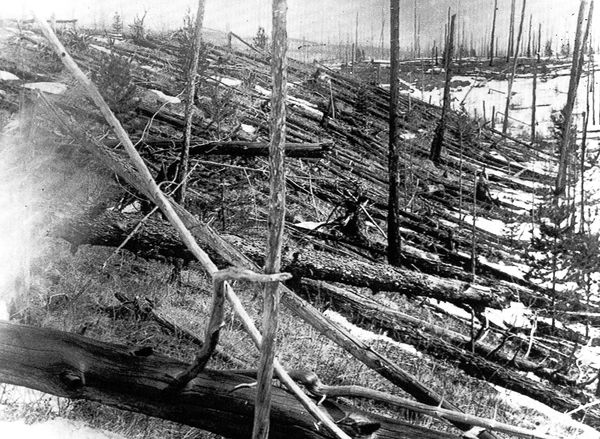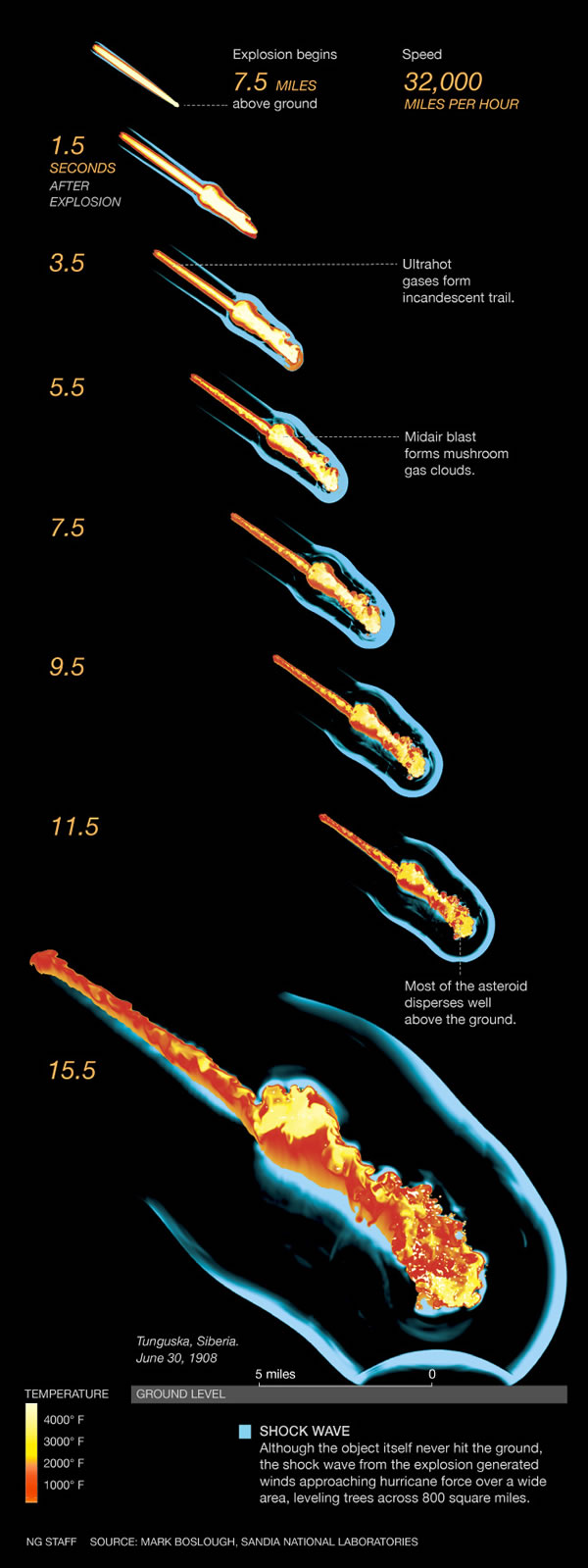Exploding Asteroids Pose Greater Threat Than Direct Hits
A 1908 asteroid toppled trees in a wide swath of Siberia, though it never hit the ground.
An asteroid bursting apart in midair over a city poses a greater threat to humanity than a long-feared "planet buster" smacking into Earth, suggests one impact expert. He calls for a revised system of planetary defense focused on detecting smaller asteroids, instead of the big ones.
Earth orbits amid a shooting gallery of meteorites and asteroids; such shooting stars can be seen crossing the sky every 15 minutes on a typical night.
Sometimes those space visitors are larger, such as the February 15 fireball that exploded over Chelyabinsk, Russia, injuring some 1,500 people in six cities across the region, or the 1908 Tunguska event that flattened 830 square miles (2,150 square kilometers) of Siberian forest.
"The chances are virtually certain that we are going to be next hit by a little asteroid that is a 'city buster,' long before we are hit by a bigger one," said physicist Mark Boslough of Sandia National Laboratories in Albuquerque, New Mexico.
In an upcoming report in the Acta Astronautica journal, Boslough proposes a new "airbust" warning system for asteroids that blow apart in midair rather than blasting big holes in the ground.
"We really need to come up with a way to warn people," he said.
Over the last two decades, astronomers have focused on detecting the biggest "near-Earth" asteroids, ones more than 500 feet (140 meters) wide that cross Earth's orbit.
About 95 percent of the largest ones, more than 0.6 mile (1 kilometer) across in size, are thought to have been discovered. Ironically, their paucity—none look headed our way anytime soon—explains some of the concern about airbursts.
Jupiter Impact
The fatal dive of Comet P/Shoemaker-Levy 9 into the atmosphere of Jupiter in 1994 raised astronomers' interest in airburst effects from space objects, Boslough said.
"The comet hit the outer atmosphere and exploded," he said. "The whole process started people thinking there were a lot of similarities to airbursts in Earth's atmosphere."
In the new report, Boslough looks at the 1908 Tunguska event and the Libyan desert airburst event more than 28 million years ago that melted desert sand and left yellow silica glass scattered over 2,300 square miles (6,000 square kilometers) of the Sahara.
Recent simulations by Boslough had "downgraded" the power of the 1908 event, which, rather than being comforting, alarmed scientists. "We now know these small asteroids can do more damage than we thought, due to airbursts delivering more energy to the ground than we expected," he said.
Asteroids as small as 100 feet (30 meters) wide were seen as a significant airburst threat in a 2010 National Research Council (NRC) report on impact hazards.
Airburst Hazard Scale
In the new study, Boslough calls for starting a worldwide astronomical survey, including the launch of a satellite capable of spotting smaller asteroids to augment ongoing searches for the biggest asteroids. An example of such a warning comes from the fortuitous 20 hours of lead time that University of Arizona astronomers gave of a six-foot-wide (two-meter-wide) meteor that landed harmlessly in Kenya in 2008.
"It is virtually certain (probability > 99%) that the next destructive NEO [near-Earth object] event will be an airburst," he writes in the study, echoing points he made at an astronomy meeting in Denver earlier this week.
Modeled on hurricane warnings, his proposed airburst hazard scale for cities that could be impacted by a small asteroid has five levels:
Proposed Warning Levels
High-Altitude Airburst
No Possible Damage No evacuation needed.
High-Altitude Airburst
Minor Damage Avoid standing near windows.
High-Altitude Airburst
Major Damage Take cover in basements.
Low-Altitude Airburst
Heavy Blast Damage Evacuate blast zone.
Low-Altitude Airburst
Heavy Thermal Damage Evacuate and take cover outside blast zone.
One Airburst: Tunguska
Shown below in a supercomputer simulation, the "Tunguska event" flattened 830 square miles (2,150 square kilometers) of remote Siberian forest. Boslough's proposed warning level system would consider it a class four airburst, requiring those in the area to evacuate.
Russian Meteor Warning
"What is new is the Chelyabinsk event," said asteroid hazard expert Jay Melosh of Purdue University in Indiana. The Russian fireball arrived from the direction of the sun with no warning, exploding with a force of 440 kilotons of TNT on its trip through the Earth's atmosphere—more than 20 times stronger than the atomic bomb blast dropped on Hiroshima in 1945. "We had warned about the hazard, but here we saw it up close."
The question is what kind of civil defense system makes the most sense for dealing with an airburst, Melosh added. He is less confident than Boslough about the possibility of astronomers detecting small asteroids headed our way with enough reliability to support an early warning system.
"It may be that what we can best do is give civil defense authorities some indication of what sort of damage they may encounter after an airburst to help recovery efforts," Melosh said.
Sky Does Fall at Times
"No one disputes that airburst events are far more frequent than impacts that threaten global civilization," MIT impact expert Richard Binzel said by email.
"This work is a next step toward quantifying potential damage of very localized events and communicating to civil agencies."
Still, he and Melosh said airburst worries shouldn't stop astronomers looking out for a "planet buster" asteroid or comet out there headed for Earth. Boslough agrees, saying his proposal only adds to planetary defense efforts.
Binzel warns that funding for a short-warning airburst civil defense system might be hard to find. The 2010 NRC report scolded the U.S. government for stiffing astronomers it had asked to search for asteroids.
"Airbursts simply are part of the suite of natural disasters that include tornadoes and hurricanes," he said. "They are simply so rare for any one location that there is no particular attention paid. However, planning general scenarios makes good sense."
Dan Vergano
National Geographic
Published October 15, 2013













